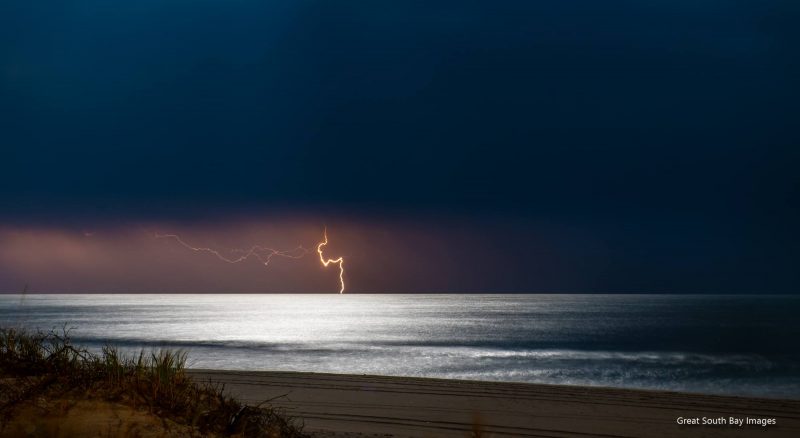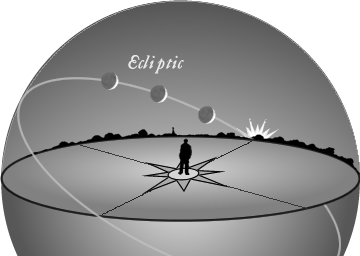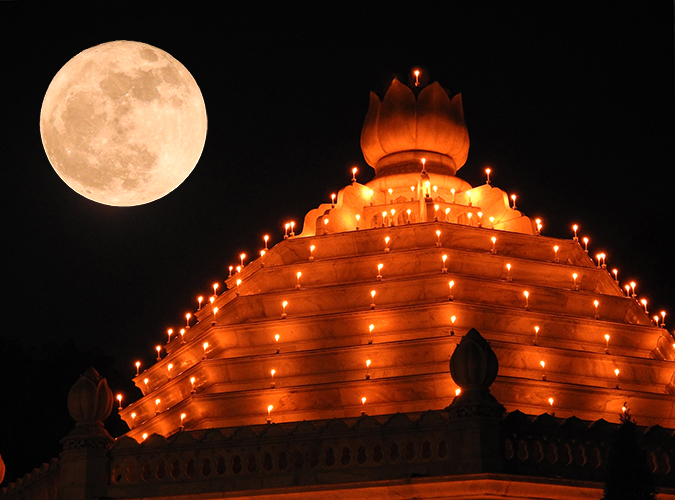

Hunter’s Moon light on the ocean – October 23, 2018 – from Michael Busch in Long Island, New York. See more photos of 2018’s Hunter’s Moon.
In skylore, every full moon has many names, and most are tied to months of the year. But some moon names are tied to seasons, such as the Harvest and Hunter’s Moons. The Harvest Moon is the full moon closest to the autumnal equinox. The Hunter’s Moon is the full moon after the Harvest Moon. For us in the Northern Hemisphere, 2019’s 2019 Harvest Moon came on September 13-14. So the upcoming full moon – around October 12-13, 2019 – is the Northern Hemisphere’s Hunter’s Moon.
What makes a Hunter’s Moon special? Nature is particularly cooperative around the time of the autumn equinox to make the fall full moonrises unique.
The 2020 lunar calendars are here! Order yours before they’re gone. Makes a great gift.

Rising Hunter’s Moon. Photo by Abhinav Singhai, 2014.
Here’s what happens. On average, the moon rises about 50 minutes later each day. But when a full moon happens close to the autumnal equinox – either a Harvest or a Hunter’s Moon – the moon (at mid-temperate latitudes) rises only about 30 to 35 minutes later daily for several days before and after the full moon. The reason is that the ecliptic – or the moon’s orbital path – makes a narrow angle with the evening horizon around the time of the autumn equinox.
The result is that there’s a shorter-than-usual lag time between successive moonrises around the full Hunter’s Moon.
These early evening moonrises are what make every Hunter’s Moon special. Every full moon rises around sunset. After the full Hunter’s Moon, you’ll see the moon ascending in the east relatively soon after sunset for a few days in a row at northerly latitudes.
If you’re in the Northern Hemisphere, look for the moon to be bright and full-looking for several nights beginning around October 11 and 12. Keep watching on October 13 and 14. Around all of these nights, you’ll see a bright round moon in your sky, rising around the time of sunset, highest in the middle of the night.

In autumn, the angle of the ecliptic – or sun and moon’s path – makes a narrow angle with the horizon. Image via ClassicalAstronomy.com.

The narrow angle of the ecliptic means the moon rises noticeably farther north on the horizon from one night to the next. So there is no long period of darkness between sunset and moonrise, and, around the time of full moon, many people see the moon in a twilight sky. Image via ClassicalAstronomy.com.
For all of us, the precise time of full moon is Sunday, October 13, 2019, at 21:08 UTC; translate UTC to your time.
The times don’t really matter. No matter where you live worldwide, look for a full-looking moon in the east as the sun goes down over the next several days. This full or full-looking moon will cross our skies throughout the night, as seen from around the globe.
Want to know the time of moonrise in your location? My favorite source of that information is this Custom Sunrise Sunset Calendar. Once you get to that page, be sure to click the box for “moon phases” and “moonrise and moonset times.”

Swami Krishnananda in Ranchi, India, wrote: “What is known as Hunter’s Moon in the West is called Kartik Purnima in India, and it is a sacred festival celebrated all over India. The photo was taken in Ranchi during this celebration, when a marble temple dedicated to Paramahansa Yogananda [author of the amazing book Autobiography of a Yogi] was lit up with candles.” Thank you, Swami Krishnananda!
Is a Hunter’s Moon always bigger, or brighter or more colorful? No. The Hunter’s Moon is just an ordinary full moon with a special path across our sky. Still, many of us do think the Hunter’s Moon always looks bigger … or brighter … and more orange than usual. Why?
It’s because the Hunter’s Moon has a powerful mystique. Many people look for it shortly after sunset around the time of full moon. After sunset around any full moon, the moon will always be near the horizon … because full moons rise at sunset. It’s the location of the moon near the horizon that causes the Hunter’s Moon – or any full moon – to look big and orange in color.
Orange moon near the horizon. The orange color of a moon near the horizon is a true physical effect. It stems from the fact that, when you look toward the horizon, you’re looking through a greater thickness of Earth’s atmosphere than when you gaze up and overhead. The atmosphere scatters blue light – that’s why the sky looks blue. The greater thickness of atmosphere in the direction of a horizon scatters blue light most effectively, but it lets red light pass through to your eyes. So a full moon near the horizon – any full moon near the horizon – takes on a yellow or orange or reddish hue.
Big moon near the horizon. The bigger-than-usual size of a moon seen near the horizon is something else entirely. It’s a trick that your eyes are playing – an illusion – called the Moon Illusion. You can find lengthy explanations of the Moon Illusion by googling those words yourself.
How did the Hunter’s Moon get its name? We hear many, many different explanations for the name Hunter’s Moon.
In the autumn months, there’s no long period of darkness between sunset and moonrise for several days in a row, around the time of full moon. In the days before tractor lights, the lamp of the Harvest Moon helped farmers to gather their crops, despite the diminishing daylight hours. As the sun’s light faded in the west, the moon would soon rise in the east to illuminate the fields throughout the night. A month later, after the harvest was done, the full Hunter’s Moon was said to illuminate the prey of hunters, scooting along in the stubble left behind in the fields.
Who named the Harvest and Hunter’s Moon? Those names probably sprang to the lips of farmers and hunters throughout the world, on autumn evenings, at times of the full moon.

Full Hunter’s Moon rising over the Bothnian Sea, Sweden, on November 4, 2017, via Jörgen Norrland Andersson.
What if I’m in the Southern Hemisphere? If you’re in the Southern Hemisphere, your Harvest and Hunter’s moons center on the March equinox, your autumn equinox. Much of what we say in his post – the general information about Harvest and Hunter’s Moons – applies to you, too … next March and April. Right now, your full moon will be doing the opposite of a Hunter’s Moon. That is, for the Southern Hemisphere around the time of the October and November full moons, there’s a longer-than-usual time between moonrises on successive nights.
Bottom line: The Hunter’s Moon for the Northern Hemisphere in 2019 comes around the full moon of October 12-13. Learn the lore of the Hunter’s Moon – and what to look for – here.
See more great photos of 2018’s Hunter’s Moon
from EarthSky https://ift.tt/324iQux


Hunter’s Moon light on the ocean – October 23, 2018 – from Michael Busch in Long Island, New York. See more photos of 2018’s Hunter’s Moon.
In skylore, every full moon has many names, and most are tied to months of the year. But some moon names are tied to seasons, such as the Harvest and Hunter’s Moons. The Harvest Moon is the full moon closest to the autumnal equinox. The Hunter’s Moon is the full moon after the Harvest Moon. For us in the Northern Hemisphere, 2019’s 2019 Harvest Moon came on September 13-14. So the upcoming full moon – around October 12-13, 2019 – is the Northern Hemisphere’s Hunter’s Moon.
What makes a Hunter’s Moon special? Nature is particularly cooperative around the time of the autumn equinox to make the fall full moonrises unique.
The 2020 lunar calendars are here! Order yours before they’re gone. Makes a great gift.

Rising Hunter’s Moon. Photo by Abhinav Singhai, 2014.
Here’s what happens. On average, the moon rises about 50 minutes later each day. But when a full moon happens close to the autumnal equinox – either a Harvest or a Hunter’s Moon – the moon (at mid-temperate latitudes) rises only about 30 to 35 minutes later daily for several days before and after the full moon. The reason is that the ecliptic – or the moon’s orbital path – makes a narrow angle with the evening horizon around the time of the autumn equinox.
The result is that there’s a shorter-than-usual lag time between successive moonrises around the full Hunter’s Moon.
These early evening moonrises are what make every Hunter’s Moon special. Every full moon rises around sunset. After the full Hunter’s Moon, you’ll see the moon ascending in the east relatively soon after sunset for a few days in a row at northerly latitudes.
If you’re in the Northern Hemisphere, look for the moon to be bright and full-looking for several nights beginning around October 11 and 12. Keep watching on October 13 and 14. Around all of these nights, you’ll see a bright round moon in your sky, rising around the time of sunset, highest in the middle of the night.

In autumn, the angle of the ecliptic – or sun and moon’s path – makes a narrow angle with the horizon. Image via ClassicalAstronomy.com.

The narrow angle of the ecliptic means the moon rises noticeably farther north on the horizon from one night to the next. So there is no long period of darkness between sunset and moonrise, and, around the time of full moon, many people see the moon in a twilight sky. Image via ClassicalAstronomy.com.
For all of us, the precise time of full moon is Sunday, October 13, 2019, at 21:08 UTC; translate UTC to your time.
The times don’t really matter. No matter where you live worldwide, look for a full-looking moon in the east as the sun goes down over the next several days. This full or full-looking moon will cross our skies throughout the night, as seen from around the globe.
Want to know the time of moonrise in your location? My favorite source of that information is this Custom Sunrise Sunset Calendar. Once you get to that page, be sure to click the box for “moon phases” and “moonrise and moonset times.”

Swami Krishnananda in Ranchi, India, wrote: “What is known as Hunter’s Moon in the West is called Kartik Purnima in India, and it is a sacred festival celebrated all over India. The photo was taken in Ranchi during this celebration, when a marble temple dedicated to Paramahansa Yogananda [author of the amazing book Autobiography of a Yogi] was lit up with candles.” Thank you, Swami Krishnananda!
Is a Hunter’s Moon always bigger, or brighter or more colorful? No. The Hunter’s Moon is just an ordinary full moon with a special path across our sky. Still, many of us do think the Hunter’s Moon always looks bigger … or brighter … and more orange than usual. Why?
It’s because the Hunter’s Moon has a powerful mystique. Many people look for it shortly after sunset around the time of full moon. After sunset around any full moon, the moon will always be near the horizon … because full moons rise at sunset. It’s the location of the moon near the horizon that causes the Hunter’s Moon – or any full moon – to look big and orange in color.
Orange moon near the horizon. The orange color of a moon near the horizon is a true physical effect. It stems from the fact that, when you look toward the horizon, you’re looking through a greater thickness of Earth’s atmosphere than when you gaze up and overhead. The atmosphere scatters blue light – that’s why the sky looks blue. The greater thickness of atmosphere in the direction of a horizon scatters blue light most effectively, but it lets red light pass through to your eyes. So a full moon near the horizon – any full moon near the horizon – takes on a yellow or orange or reddish hue.
Big moon near the horizon. The bigger-than-usual size of a moon seen near the horizon is something else entirely. It’s a trick that your eyes are playing – an illusion – called the Moon Illusion. You can find lengthy explanations of the Moon Illusion by googling those words yourself.
How did the Hunter’s Moon get its name? We hear many, many different explanations for the name Hunter’s Moon.
In the autumn months, there’s no long period of darkness between sunset and moonrise for several days in a row, around the time of full moon. In the days before tractor lights, the lamp of the Harvest Moon helped farmers to gather their crops, despite the diminishing daylight hours. As the sun’s light faded in the west, the moon would soon rise in the east to illuminate the fields throughout the night. A month later, after the harvest was done, the full Hunter’s Moon was said to illuminate the prey of hunters, scooting along in the stubble left behind in the fields.
Who named the Harvest and Hunter’s Moon? Those names probably sprang to the lips of farmers and hunters throughout the world, on autumn evenings, at times of the full moon.

Full Hunter’s Moon rising over the Bothnian Sea, Sweden, on November 4, 2017, via Jörgen Norrland Andersson.
What if I’m in the Southern Hemisphere? If you’re in the Southern Hemisphere, your Harvest and Hunter’s moons center on the March equinox, your autumn equinox. Much of what we say in his post – the general information about Harvest and Hunter’s Moons – applies to you, too … next March and April. Right now, your full moon will be doing the opposite of a Hunter’s Moon. That is, for the Southern Hemisphere around the time of the October and November full moons, there’s a longer-than-usual time between moonrises on successive nights.
Bottom line: The Hunter’s Moon for the Northern Hemisphere in 2019 comes around the full moon of October 12-13. Learn the lore of the Hunter’s Moon – and what to look for – here.
See more great photos of 2018’s Hunter’s Moon
from EarthSky https://ift.tt/324iQux


Aucun commentaire:
Enregistrer un commentaire